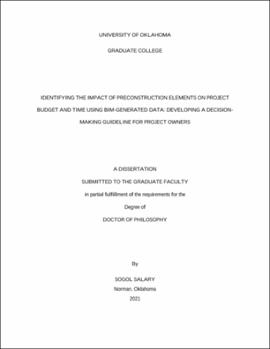| dc.contributor.advisor | Reyes, Matthew | |
| dc.contributor.author | Salary, Sogol | |
| dc.date.accessioned | 2021-10-15T22:10:59Z | |
| dc.date.available | 2021-10-15T22:10:59Z | |
| dc.date.issued | 2021 | |
| dc.identifier.uri | https://hdl.handle.net/11244/331087 | |
| dc.description.abstract | Preconstruction is the preliminary part of a project’s lifecycle during which the plan for construction is established. There are many critical decisions made during this phase that may lead to variances in preconstruction budget and time. Controlling budget variances is a key objective during the preconstruction phase. Projects with low budget stability may have poor outcomes such as low project quality, inaccurate information for financial planning by owners, instabilities in project timeline, and other challenges to project success. To control for this, project owners should be familiar with critical decisions related to variances in their project budget and time during the preconstruction phase. Project owners should prioritize these decisions while holding off on decisions that are not likely to impact their budget significantly. The aim of this study was to aid project owners with identifying critical preconstruction decisions that may cause major variances in a project budget during the preconstruction phase. To develop a decision-making guideline rooted in objective data rather than subjective information, advanced preconstruction platforms (such as BIM) and other technologies were employed to measure objective data on preconstruction elements. Data were collected from 61 projects nationwide. Three statistical methods (ANOVA, T-test, and correlation) were used to identify critical preconstruction elements that impact variances in the preconstruction budget. During the data analysis, additional results related to the impact of preconstruction elements on the time needed to complete preconstruction were also obtained. Therefore, the data obtained using advanced preconstruction platforms were used to deliver information about project budget and time, two key attributes of a successful project, and to empower project owners on having a productive decision-making process during the preconstruction phase. The findings indicate that critical decisions causing significant variances in the preconstruction budget and time are identifiable and should be prioritized over decisions that are not critical. Additionally, the findings provide the novel opportunity to inform project owners’ decisions using a decision-making guideline rooted in objective data as opposed to other existing tools that utilize subjective information. Project owners will be able to use this guideline to prioritize critical decisions and reduce the risk of having budget variances during the preconstruction phase. | en_US |
| dc.language | en | en_US |
| dc.subject | Preconstruction Elements | en_US |
| dc.subject | Decision-Making Guideline | en_US |
| dc.subject | Project Budget and Time | en_US |
| dc.subject | Building Information Modeling (BIM) | en_US |
| dc.title | Identifying the impact of preconstruction elements on project budget and time using BIM-generated data: developing a decision-making guideline for project owners | en_US |
| dc.contributor.committeeMember | Ghosh, Somik | |
| dc.contributor.committeeMember | Perrenoud, Anthony | |
| dc.contributor.committeeMember | Lowery, Bryce C. | |
| dc.contributor.committeeMember | Karr, Liz | |
| dc.date.manuscript | 2021-10-14 | |
| dc.thesis.degree | Ph.D. | en_US |
| ou.group | Christopher C. Gibbs College of Architecture | en_US |
| shareok.orcid | 0000-0003-1720-4635 | en_US |
| shareok.nativefileaccess | restricted | en_US |
